What is the meaning of “Xiaohongshu” brand name
Xiaohongshu, as pronounced, stands for three Chinese characters which are 小 (xiao), 红 (hong) and 书 (shu). When translated it means “the Little Red Book” and it’s sometimes referred to as the «RED» app, but the brand name can imply many different meanings in China.
In Chinese history, the Little Red Book is also known as Mao’s Little Red Book. It was a pocket-sized red book that included famous speeches and writings from Chairman Mao Zedong. The books were distributed by the government during the Cultural Revolution in China to spread the key ideology and all people during the time were legally obliged to carry with them. Though this political history likely has no connection with the current brand name, however, the familiarity of “The Little Red Book” for the Chinese may have helped the brand to easily build brand awareness.
How Little Red Book works with international brands?
In recent years, Little Red Book Xiaohongshu has been actively collaborating with international brands to expand its offerings and attract more users.
For example, Little Red Book Xiaohongshu partnered with luxury brand Dior to create a flagship store on the platform. This allowed Dior to showcase its products to Xiaohongshu’s millions of users and provide them with a seamless shopping experience.
Dior’s Brand Account and Store on Little Red Book
Little Red Book Xiaohongshu has also collaborated with international influencers and celebrities to promote brands and products on the platform. For example, in 2020, the platform partnered with Victoria Beckham to launch her beauty line in China, and the campaign featured a number of popular Xiaohongshu influencers promoting the products.
Overall, Xiaohongshu’s collaborations with international brands have helped to diversify its offerings and attract a wider range of users. By partnering with established brands and influencers, Little Red Book Xiaohongshu has been able to leverage their existing fan bases and expand its reach beyond China.
A Long Time Coming
Back in June of this year, we noticed that Xiaohongshu was quietly testing livestreaming, and we predicted back then that it was going to launch an e-commerce livestreaming feature sometime this year. Many marketers have been expecting this move, as Xiaohongshu’s lead investor is Alibaba, who, as we mentioned, is a leader in e-commerce live-streaming.
“After the initial trial in June, Xiaohongshu started to push vlogs and longer videos, changing the video length limit from one minute to five, says Miro Li, Co-Founder of Xiaohongshu marketing agency Double V Consulting. “This was clearly in preparation for launching the live-streaming function while content creators became accustomed to creating long-form video and users simultaneously became accustomed to watching more and longer videos. According to Xiaohongshu, over the past year, the number of video posts increased 265 percent each month, and vlogs received 100 million views per month.”
Xiaohongshu is being cautious about adding the new feature, recognizing it could have a huge impact on its community. At the recent Creators Day conference where they announced the livestreaming feature, Xiaohongshu’s Community Director Ke Nan said, “Before launching the feature, we are very focused on first assessing two key areas. First: Is live-streaming actually a good fit for our platform? Which content creators might be good at live-streaming? And which type of live-streaming are they good at — selling products or interacting and entertaining their audience? Second: We will work with our existing brand partners to test the feature.”
Is XiaoHongShu Advertising Right for Your Business?
As one of the fastest growing platforms not just within China, but amongst Chinese-speaking communities overseas — XiaoHongShu’s unique blend of social media and e-commerce is a hit amongst its Millenial and Gen Z users.
In a world where consumers are constantly overwhelmed by ads every day, XiaoHongShu’s focus on user-generated reviews, opinions and interactions is a breath of fresh air. Brands looking to capture a slice of the Chinese-speaking Millenials and Gen Z market would benefit greatly from advertising on XiaoHongShu.
However, what if you’re not selling in China? Can a Singaporean business still benefit from advertising on XiaoHongShu even if they’re not able to take advantage of the platform’s e-commerce features? We say yes!
A quick look at the XiaoHongShu app shows hundreds of posts by Chinese consumers living in Singapore. If your brand’s target audience is Chinese speaking, XiaoHongShu can still be an excellent platform to build word-of-mouth brand awareness.
Read also:
- 7 Best Free and Paid XiaoHongShu Courses and Certifications
- 8 Tips and Tricks to Sell on XiaoHongShu 小红书 (Little Red Book)
- XiaoHongShu Marketing: Guide on Little Red Book eCommerce
- Guide on How to Sell on XiaoHongShu in Singapore
- What is XiaoHongShu 小红书 and How to Use It
We Can Help You Reach Out to Chinese Distributors!
Little Red Book aka XiaoHongShu is a powerful social media platform that can help businesses attract Chinese distributors. With its massive user base (especially among Chinese women) and focus on fashion and luxury products, Little Red Book is a great marketing tool for brands looking to expand into the Chinese market.
By optimizing their brand profile and collaborating with Chinese influencers, businesses can effectively target Chinese millennials and tap into the booming e-commerce market in China.

We are a Shanghai-based marketing agency offering digital marketing and e-commerce services to Western companies interested in entering the Chinese market. We’ve been in the business for more than 10 years, and our Chinese and foreign experts have the expertise and know-how needed in this lucrative, yet very complicated market.
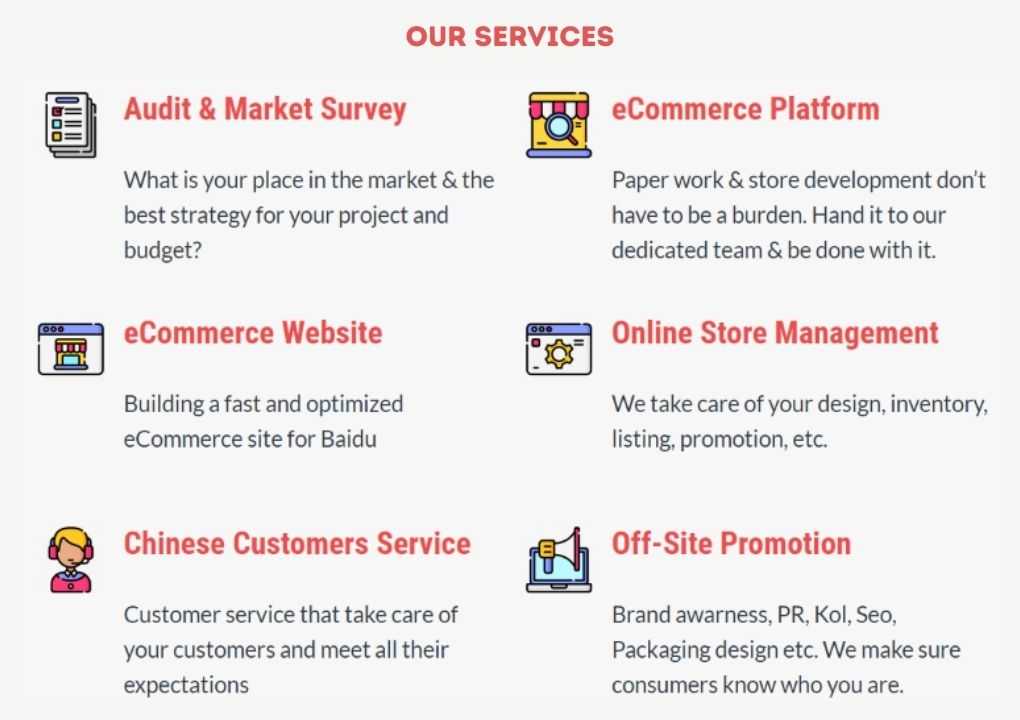
As you can see above, we offer many services, ranging from social media management, to influencer marketing and Baidu SEO optimization. If you’re interested in entering Chinese e-commerce or you’d like to know about Little Red Book and how to sell your products and reach Chinese distributor on the platform, you found the right place.
Leave us a comment or contact us, so that we can schedule a call with one of our experts that will learn about your brand and guide you through all the steps you need to take for your brand/brands on Little Red Book. Let’s keep in touch!

How to touch target users in the fastest way?
In addition to the organic posts on Little Red Book, brands can also release product/brand introduction articles/videos directly on the Little Red Book app in the form of information flow.
When advertisers place infomercials on Little Red Book, they can better find their target users through targeting settings such as gender, age, region, mobile device, etc., and show their ads directly in front of them, so they can get better and better advertising results.
Little Red Book app has already opened its commercial ecology of information flow advertising. Official brand accounts release native notes: brand partners write/share their notes to amplify the influence of brand content.
Young users search for information by browsing notes shared on Little Red Book. They are willing to try new products recommended when they see it, and they are also glad to share their experience after using/testing products, which generates more attention and sales conversion for brands.
From a shopping guide to a community to e-commerce
It all started in Hongkong, one of the favorite overseas travel destinations for mainland Chinese people. Despite the western ambiance and exquisite Cantonese cuisine, one of the main purposes of travel was shopping.
Yet, due to the language barrier and lack of knowledge about foreign brands, many Chinese travelers were wondering, “Which handbag should I buy as my first luxury item? Which skin moisturizer is worth a try? How can I do a tax-refund?” Little Red Book co-founder Mao saw that information gap and started the first version of Little Red Book – Little Red Book Hongkong Shopping Guide – offering shopping-related information for mainland Chinese consumers from those who traveled or lived in Hongkong.
чем RED лучше тмалл?
Little Red Book (Xiaohongshu) и Tmall — это две разные платформы для электронной коммерции в Китае, каждая со своими особенностями и преимуществами. Вот несколько плюсов Store на Little Red Book по сравнению с Tmall:
- Фокус на контенте и влиянии: Little Red Book известен своим сильным акцентом на пользовательский генерируемый контент. Пользователи делятся отзывами, обзорами, фотографиями и видео относительно продуктов и брендов, что создает аутентичные истории и рекомендации. Это позволяет брендам строить более глубокие взаимоотношения с аудиторией и устанавливать лояльность.
- Социальное взаимодействие: Little Red Book предоставляет более социальное и интерактивное взаимодействие с пользователями. Это означает, что бренды могут взаимодействовать с покупателями более органично, создавать чаты и обсуждения, что способствует построению сообщества вокруг бренда.
- Аутентичность и персонализация: Платформа способствует более персонализированной и целенаправленной рекламе, используя данные о предпочтениях пользователей. Это позволяет брендам достигать более высокой релевантности в своих кампаниях.
- Микро-влиятели и сотрудничество с пользователями: Little Red Book позволяет брендам сотрудничать с микро-влиятелями и пользователями, что может увеличить охват и доверие к продукту или бренду.
- Уникальная аудитория: Аудитория Little Red Book часто более молодая и более заинтересована в моде, красоте и стиле жизни. Это может быть полезно для брендов, ориентированных на эту целевую группу.
Однако следует помнить, что выбор между Store на Little Red Book и Tmall зависит от бизнес-стратегии, целевой аудитории и характеристик продукта. Некоторые бренды могут выбирать обе платформы в зависимости от их уникальных преимуществ и возможностей.
How international brands can leverage Little Red Book in China
Similar to famous platforms like WeChat and Weibo, foreign companies can set up an official brand account on Little Red Book in China as well. Brands need to submit various documents such as business registration for verification and depending on the product category, required documents can be different. In recent years, more and more brands have joined Little Red Book platform. Especially some well-known luxury brands, such as Louis Vuitton, DIOR, Gucci, Prada, Celine, and Balenciaga, have all opened Little Red Book accounts.
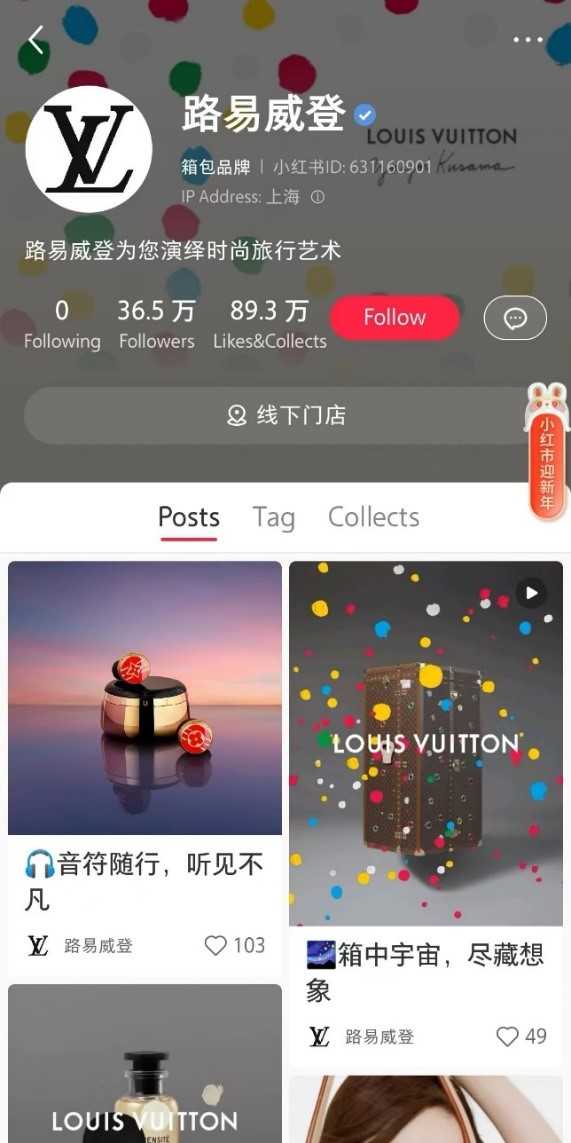
Source: Little Red Book, Official account of French brand Louis Vuitton with more than 365,000 followers
Working with KOLs and KOCs: Online influencers in China
Even if a brand has neither an official account nor a shop selling its products on Little Red Book, it could still be very beneficial to leverage this app to engage with Chinese consumers. Working with KOLs and KOCs is crucial in China since Chinese consumers assume that online influencers are more trustworthy than “official” ads.
In China, KOL marketing is one of the main ways that brands are using to reach their target audience. KOL stands for Key Opinion Leader, who can settle new trends, widen a brand’s audience, increase brand awareness, and motivate customers to purchase from online and offline channels. In 2020, KOLs influenced 48% of interviewed Gen Z shoppers. When collaborating with a KOL, it is of major importance to find the right person, whose image is compatible with your brand and whose followers are your target groups. The simplest way to reach out to a KOL is by sending them free samples of your product.
Meanwhile, as Chinese consumers are increasingly sensitive to authenticity, KOC marketing is also a great way worth considering. KOCs, also known as Key Opinion Consumers, are the micro-influencers of China. The main benefit of collaborating with KOCs on Little Red Book in China is that they are perceived as more authentic, they are more loyal to a brand, and much less expensive. However, a KOC’s influence is minimal compared to a KOL. The infographic below weighs pros and cons of both KOLs and KOCs.
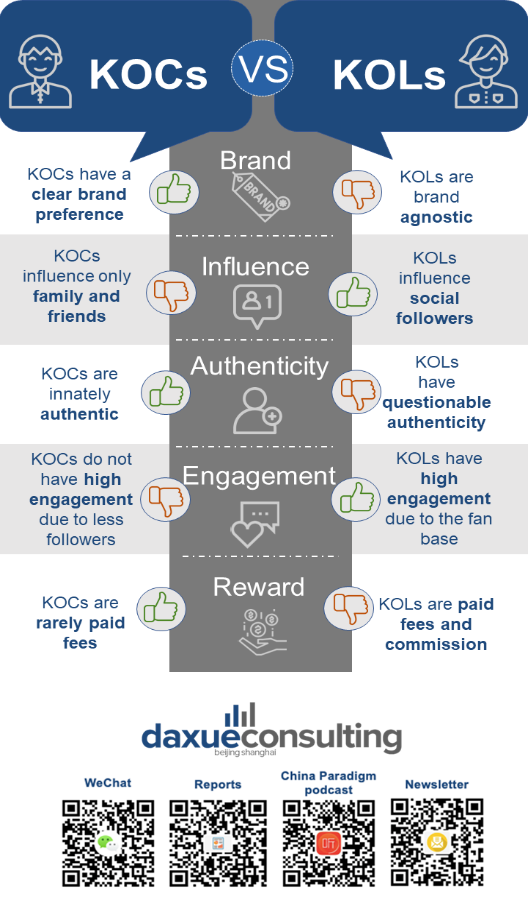
Source: daxue consulting, comparing KOLs and KOCs in China
Live streaming: a new traffic entrance
The Chinese social-commerce platform launched its live-streaming function in March 2020.
During the Spring Festival in 2021, the live-streaming of Little Red Book rose sharply compared to the previous year, with an average daily click-through rate of 17.53%. In total, the estimated sales of live streamed goods were 198 million RMB, and the average unit price was over 100 RMB. Compared to the live streaming of other e-commerce platforms, Little Red Book has a higher sale price, higher repeat purchase rate, and lower refund rates.
An important factor for Little Red Book’s success in live streaming is the high stickiness of KOL fans. Before the launch of live-streaming, KOLs have already kept a good interaction with fans. This provides a solid platform for successful live steaming. Even without Li Jiaqi (the top KOLs of Taobao), Little Red Book still attracts many brands and KOCs to live stream and get in touch with followers directly. More importantly, Little Red Book is good at training quality KOCs and create loyal customers.
First impressions… a beauty and fashion platform for women
Previously, I had considered Xiaohongshu to be more of a female-focused platform, dominated by beauty and outfit of the day (OOTD) content so I wasn’t that interested in using it. Indeed, the majority of Xiaohongshu users are young, female city-dwellers: women account for 88.37% of users, and more than 56% of Xiaohongshu’s userbase live in the four first-tier cities of Beijing, Shanghai, Guangzhou and Shenzhen. Due to its popularity among women, the top three topics on the platform are fashion (9.98%), beauty and makeup (9.85%), and gourmet food (8.05%), according to Qiangua Data.

However, after I started exploring Xiaohongshu earlier this year, I realised it was also home to lots of interesting and talented creators. The range of content – education, overseas life, comedy etc – changed my initial perceptions about the platform.
Improved Analytics, Affiliate Links, and Paid Content
While the announcement about the live-streaming feature has generated the most buzz, Xiaohongshu also shared several other new features they’re working on:
- An improved creators center that offers creators better analysis of their content trends and their followers’ interests
- Courses to help creators at varying stages improve their content-creating skills
- New tools such as comment management and canned responses for DMs
- A feature similar to affiliate links that allow creators to add a “product card” into their content, and if users purchase products through that card, creators will receive a commission
And finally, they also announced that they’re currently testing paid posts, a feature similar to Weibo’s Fan Headline (粉丝头条) and Douyin’s DOU+. Creators and brands will be able to pay as low as 100 RMB, select a target audience, and have their content pushed to that audience. While one could argue that this is beneficial for content creators wanting additional exposure, any creator on Weibo will tell you that this feature will have negative long-term effects on the Xiaohongshu community. Creators will have less incentive to produce high-quality content because they won’t need to have high-quality content to get views when they can just pay for views. It will also discourage smaller, new creators who won’t be able to pay for promotion and will have a harder time getting traffic. It will also damage the user experience, as users will be exposed to more paid content in their feeds.
Whether it’s adding e-commerce live-streaming or paid posts, it’s clear that Xiaohongshu is caving to the pressure to monetize. But will these features benefit or alienate the community? Only time will tell.
Best Practices for Advertising on XiaoHongShu
If you want to succeed at advertising on XiaoHongShu, you must adapt to the platform’s culture. Follow these best practices to increase your chances of successful ads and avoid any issues with XiaoHongShu’s moderation team.
Focus on Sharing not Selling
XiaoHongShu users prefer educational, informative and useful content. They visit the app to get peer recommendations and discover new products without being overwhelmed by ads.
If your ads are overly promotional, they’ll stick out like a sore thumb. Users will end up ignoring your ad or worse — have it reviewed and removed by XiaoHongShu. A soft-selling approach beats out hard-selling on XiaoHongShu.
Optimise Both Image and Text
Unlike other social media platforms where visuals may play a more important role than text, you must optimise both if you want to be successful at XiaoHongShu advertising. Remember that XiaoHongShu functions like a product search engine, so you want to ensure you have the proper keywords in your post title and text to ensure you show up on results.
That said, users are not going to click into your posts or ads if your images aren’t attractive either — so make sure they are clear and contain specific tags such as the brand or price.
Keep Your Posts Objective, Friendly and Conversational
Nothing turns XiaoHongShu users off more than pure advertorial content. When writing a copy in Chinese try to have a native speaker vet your content to ensure it doesn’t appear overly formal or promotional.
If your posts are talking about a particular product, make sure it is as objective as possible. XiaoHongShu users want to know about a product’s pros and cons. Presenting only the positives can make it seem like you are trying too hard and come across as being dishonest.
Have a Long-term, Relationship Building Perspective
While there is a place for short, promotional campaigns — brands are more likely to find advertising success on XiaoHongShu if they adopt a long-term, relationship-building perspective with their audience. This means continuously growing your brand awareness and community by actively engaging followers, consistently working with KOLs to spread word-of-mouth awareness and adopting a soft-sell approach to sales.
How Does Little Red Book (Xiaohongshu) work?
But how does the site work, exactly?
Well, Little Red Book has two sections:
- The user community
- The e-commerce platform
The Little Red Book User Community
Source: TheNextWeb
Little Red Book users can engage with platform content in three ways:
- Liking the content — similar to Facebook’s “like” feature.
- Collecting the content — saving it under a bookmark for future reference.
- Commenting on the content — interacting with the post and the user.
Little Red Book focuses heavily on building trust and reliability between the platform and consumers, rewarding users for posting suggestions and advice to followers.
By posting regular, quality content, users can quickly attract significant followings, and can even earn commission by becoming influencers — more on this below.
Source: WalkTheChat
The Little Red Book E-commerce Platform
In fact, the most popular posts on Little Red Book tend to be author-tagged lists of convenient, economical, or easy-to-use products.
The popularity of these kinds of posts shows the value of authenticity on the platform, with users rewarding influencers for realism, accessibility, and being relatable.
For an example, let’s turn to the following post — a user discussing the trials of finding products suitable for sensitive skin:
Source: TheNextWeb
Interestingly, Little Red Book avoids many typical e-commerce practices. It doesn’t allow anonymous reviews or one-click ratings, for example, instead encouraging detailed, immersive product reviews known as “notes”.
The site also includes a high focus on security, with qualified brands and retailers having to submit an application before being accepted on the platform.
All of this adds up to a unique value proposition for the platform, in that users can share content, review products, and purchase items all from the same place.
Combine this with a strong focus on trusted communities of like-minded shoppers, and it’s not hard to see why Little Red Book has resonated so strongly with users.
Now, let’s take a look at who exactly is using the platform.
What is Little Red Book Xiaohongshu and how does it work?
Little Red Book (in Chinese: 小红书 Xiaohongshu, in short RED), is a popular social e-commerce platform in China. It was founded in 2013 and has quickly become one of the leading destinations for Chinese consumers, especially young people to discover and shop for products online.
Beauty and fashion are the most popular content on Xiaohongshu
Little Red Book Xiaohongshu’s business operates on a model that combines social media and e-commerce. Little Red Book Xiaohongshu allows users to share and discover content related to fashion, beauty, travel, food, and other lifestyle topics. Users can post product reviews, recommendations, and shopping experiences, as well as follow and interact with other users.
In addition to its social features, Little Red Book Xiaohongshu also functions as an e-commerce platform where users can purchase products directly from the app. The platform has a large number of brand and merchant partners who sell their products through Little Red Book Xiaohongshu’s marketplace. Little Red Book Xiaohongshu earns revenue by charging a commission on the sales made through its platform.
Little Red Book Xiaohongshu’s business model relies heavily on user-generated content and social engagement to drive traffic and sales. By creating a community of engaged users who share their experiences and opinions on products, Little Red Book Xiaohongshu has built a strong reputation as a trusted source of information and recommendations for Chinese consumers. This has made it an attractive destination for brands and merchants looking to reach Chinese consumers and sell their products online. Thus, content Seeding on Little Red Book Xiaohongshu is one of the must-haves of Brands´ China marketing measures.
Content Cycle of Little Red Book
Brands can drive engagement by highlighting their personality
Like most other Chinese social media platforms, Xiaohongshu has a fully integrated e-commerce function and I am still figuring out how, and whether it can bring direct benefits to me. I tend to buy from the influencer rather than an official website or e-commerce site (Taobao/ Tmall/ JD). Brands should be aware that this is true of a lot of Xiaohongshu users who prefer purchasing directly from influencers. The definition of ‘influencer’ in China is rapidly evolving and the expansion of the industry is leading to growing competition with brands.
Due to being a user-generated platform at its foundation, Xiaohongshu is still very personality-driven. Therefore, it’s important for brands to highlight their individual brand philosophy and values and relate to the audience on the platform.
Brands like Neiwai and Puma do this well by not solely focussing on the functional side of their products, but also appealing to Xiaohongshu users on a more meaningful level. Lingerie brand Neiwai’s content has targeted gender and body image, and Puma uses punchy word design and interesting graphic formats on the platform.
UGC-content and micro-influencers are king
Xiaohongshu has created a platform for girls to discuss fashion and beauty the way they do with their friends offline. Peer influence is always the top motivation when it comes to consumption and on Xiaohongshu, the social community can create synergy with the in-app e-market.
Hence, influencers on Xiaohongshu are much more powerful than those on other social media. Every single user can become a micro-influencer as long as they’re willing to share their real and comprehensive experiences.
So a tailored Xiaohongshu community promotion strategy should be influencer-based and content-oriented. On the platform, there are lots of established influencers and celebrities sharing their personal favorites with their fans and their posts usually get more than 1,000 likes and 10,000 saves.
One recent example is China’s top actress Fan Bingbing, who started her Xiaohongshu account this year. She gained 600,000 fans in a month and the facial masks and cream she recommended all sold out online and offline. Fans teased that she was upset because even she couldn’t get her hands on the products she posted on Xiaohongshu.
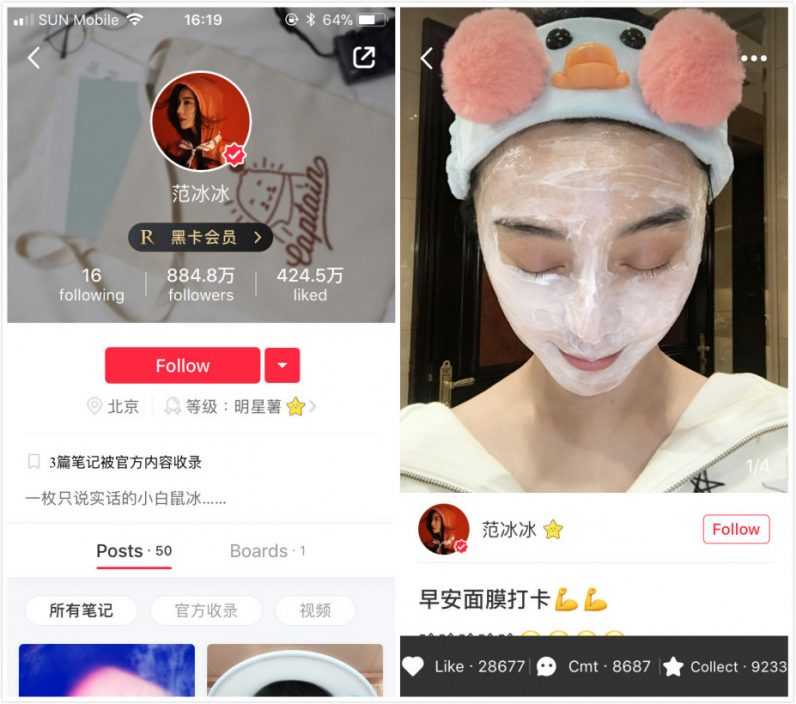
If an influencer with a following on Xiaohongshu likes your products, it can be a windfall for a brand. It can affect a brand’s image, reputation and sales.
Firstly, these influencers have strong credibility and many have other sources of income which make them less susceptible to commercial interests.
Second, their fanbase and high fan engagement improve the chances of their posts being selected and presented in the “Editor’s Pick” or “Featured” sections on the homepage of the app, so it’s hard to ignore them.
Thirdly, they understand the tastes of female users on Xiaohongshu and know how to create a popular post with viral potential.
If brands want to try influencer marketing on Xiaohongshu, they need to use a translator or Chinese team to help them to select and communicate with an influencer on the site with a steady following that fits the brand’s image, tastes and target market. They should try to contact someone that they think can truly appreciate their products and would be likely to recommend them to others.
They can then send samples and ask the influencer to try them and send their feedback. Note that influencer posts will not be too commercial or even advertorial in nature if they do like them as that may result in their account being deleted if detected by the platform. The rule is that the post needs to be an authentic and honest personal opinion.
For example, for an anti-allergy cream, influencers with sensitive skin that recommend anti-allergy products would be a good choice. Chances are that the influencer’s followers have the same or similar skin problems and are potential buyers. Note that these influencers will point out some drawbacks of the product. This is good information for the manufacturer.
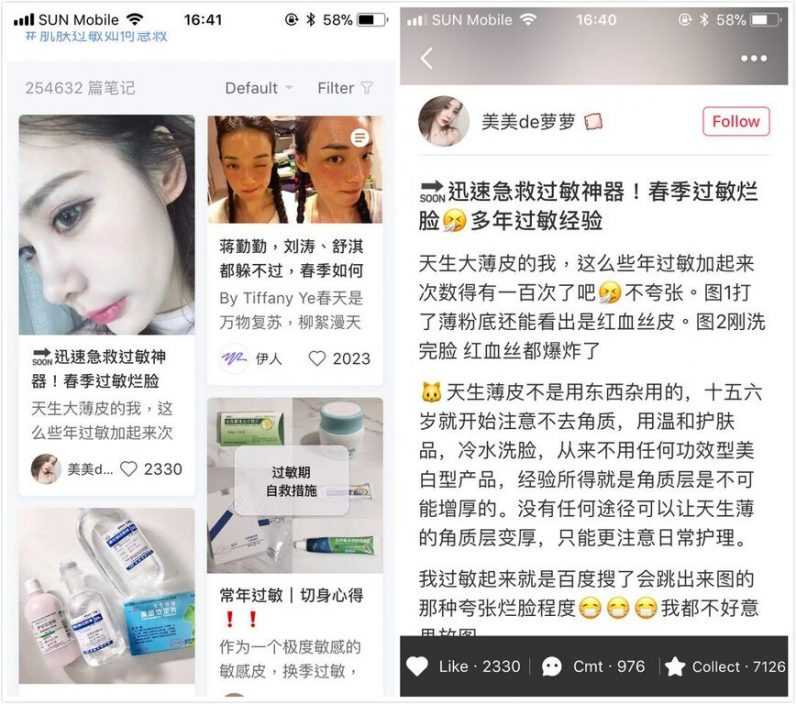
How To Get Started On Xiaohongshu
Create Content On Xiaohongshu
Xiaohongshu is commonly used by businesses and brands to gain organic growth by creating content, or to do integrated marketing by using integrated ads. Businesses may create a brand account to create their content on Xiaohongshu.
Advertising On Xiahongshu
You can sign up on Xiaohongshu’s ad platform Pugongying, where you can find influencers, their pricing for collaboration, and their past cases. Many major brands like Tiffany have had successful social marketing campaigns on Xiaohongshu.
Xiaohongshu’s ad platform PugongyingSuccessful Campaigns Showcased On Xiaohongshu
Sell On Xiaohongshu
Xiaohongshu is popular among e-commerce businesses as it allows users to browse social content while finishing transactions within the app. To open a store on Xiaohongshu, you need to follow the steps below:
Step 1. Submit your company information on Xiaohongshu’s merchants’ site.
Step 2. Wait for the Xiaohongshu team to verify your application. It usually takes 1-5 business days.
Step 3. Sign the service agreement and pay a security deposit and an annual fee.
Step 4. List products and launch your store.
Steps To Open A Store On Xiaohongshu






























